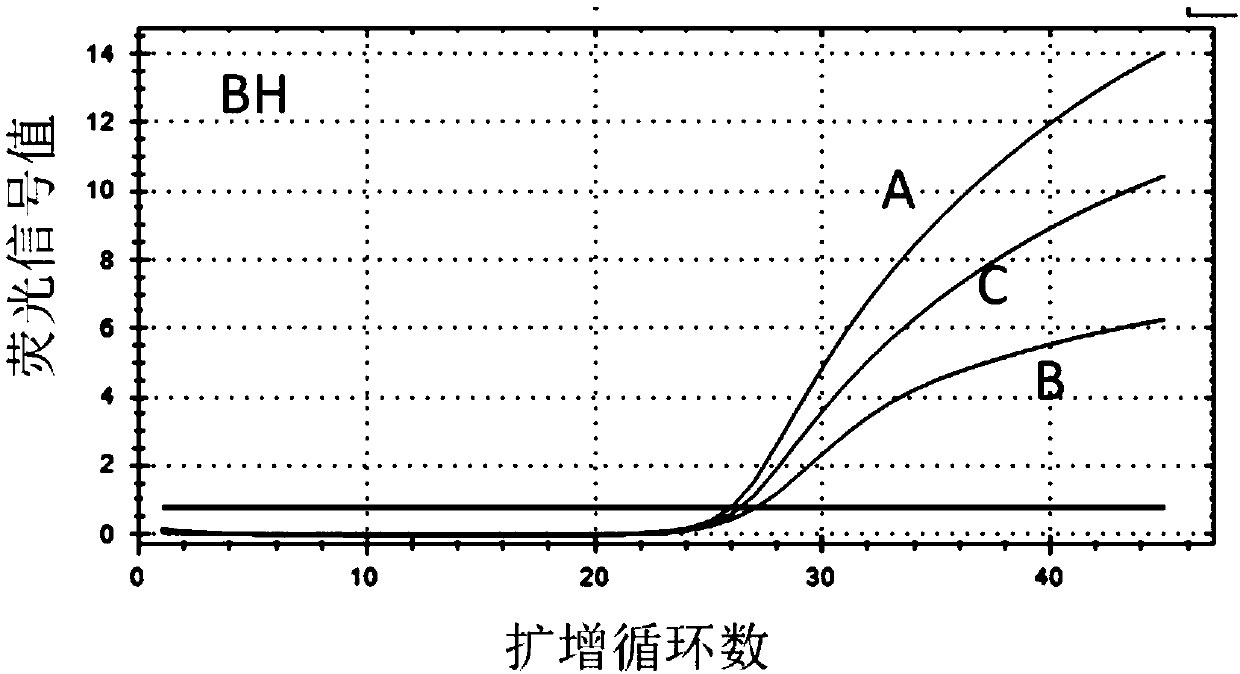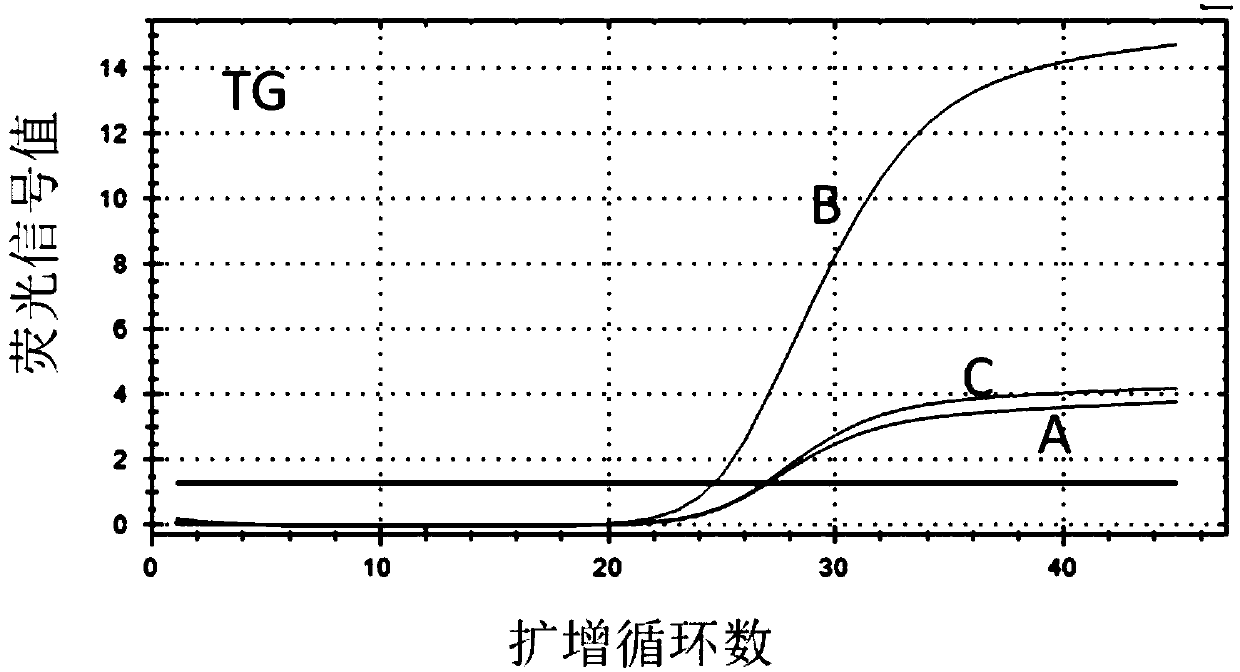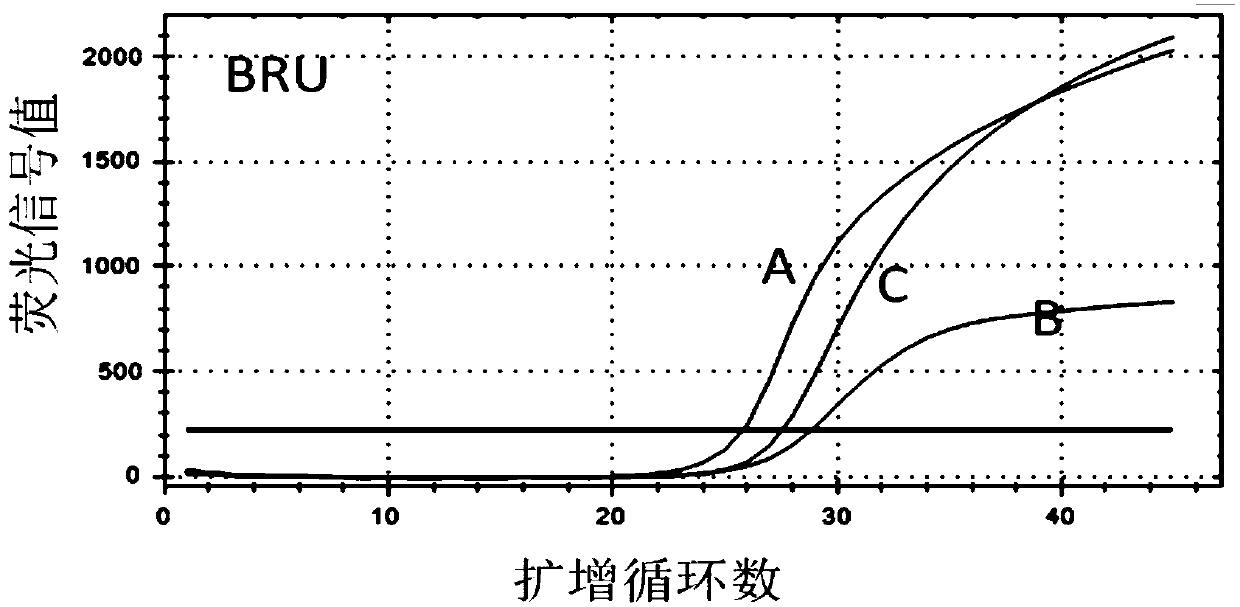Multiplex PCR primer probes and kit for detecting pet-derived zoonotic pathogens
A kit and pet technology, applied in the field of molecular biology, can solve the problems of increasing clinical testing workload and testing cost, reducing testing efficiency, etc., and achieve the effects of simplifying testing workload, excellent testing sensitivity, and shortening testing time
- Summary
- Abstract
- Description
- Claims
- Application Information
AI Technical Summary
Problems solved by technology
Method used
Image
Examples
Embodiment 1
[0039] Embodiment 1 is designed for the primer probe of target sequence
[0040] Amplifying Bartonella henselae (BH), Toxoplasma gondii (TG), and the target sequence of Brucella (BRU) in the embodiment, the inventor designed 3 sets of detection systems A and B respectively for each pathogen , Group C (Table 1 below), and compared and optimized the three systems.
[0041] Table 1
[0042]
[0043] The comparison test of different primer probes designed in Table 1 for 3 pathogens found that the following primers and probe combinations have stable fluorescence signal values and good amplification effects, see Figure 1-Figure 3 Therefore, the present invention determines that the combination of primers and probes is the best combination for detecting Bartonella henselae (BH), Toxoplasma gondii (TG) and Brucella (BRU) by fluorescent quantitative PCR.
[0044] BH detection group A BH-ITS-F CAGCGTCCATTTGGTTGATATAAA (SEQ ID NO.1) in Table 1
[0045] BH-ITS-R GAACCGATAGTTTCATAT...
Embodiment 2
[0051] Example 2 Optimization and method establishment of multiple fluorescent PCR detection experiment parameters
[0052] (1) System annealing temperature optimization: the system annealing temperature was changed from 55°C to 65°C, and the results showed that the system with an annealing temperature of 56-59°C had the best amplification effect (see Figure 4 ).
[0053] (2) Optimization of the concentration of system primers and probes: the system primers (25 μM) and probes (25 μM) were sequentially increased from 0.1 μl to 0.5 μl, each increment was 0.1 μl, and three parallel samples were made for each concentration gradient. Results The upstream and downstream primers and probes of the BH-ITS system were 0.4, 0.2, and 0.1 μl, the upstream and downstream primers and probes of the TG-529 system were 0.4, 0.2, and 0.1 μl, and the upstream and downstream primers and probes of the BRU SPP-bcsp31 system were 0.4 , 0.2, 0.1 μl, the amplification effect of the system is the best...
Embodiment 3
[0067] The specificity evaluation of embodiment 3 multiplex fluorescent PCR detection system
[0068] The multiplex fluorescent PCR method optimized in Example 2 of the present invention was used to detect 19 common pathogens and chromosomes of dogs and cats (Table 2), and the nucleic acids of BH, TG, and BRU positive clinical isolates were used as positive controls. As a result, except for the positive control, all the other pathogenic templates were negative ( Figure 5 ).
[0069] Table 2 Common pet pathogen templates
[0070]
[0071]
[0072] ICDC, Institute of Infectious Diseases Prevention and Control, Chinese Center for Disease Control and Prevention.
[0073] BMU, Peking University First Hospital Fungi Collection.
PUM
 Login to View More
Login to View More Abstract
Description
Claims
Application Information
 Login to View More
Login to View More - R&D
- Intellectual Property
- Life Sciences
- Materials
- Tech Scout
- Unparalleled Data Quality
- Higher Quality Content
- 60% Fewer Hallucinations
Browse by: Latest US Patents, China's latest patents, Technical Efficacy Thesaurus, Application Domain, Technology Topic, Popular Technical Reports.
© 2025 PatSnap. All rights reserved.Legal|Privacy policy|Modern Slavery Act Transparency Statement|Sitemap|About US| Contact US: help@patsnap.com



